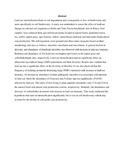Impact Of Land Use Intensity On Selected Soil Organisms In Taita And Embu Benchmark Sites, Kenya

View/
Date
2011Author
Kimenju, J.W.
Wachira, P.M.
Karanja, N.K.
Okoth, S.A.
Kahindi, J.P.H.
Jefwa, J.M
Nyamasyo, G.N
Muya, E.
Mutsotso, B.
Gikungu, M.
Kibberenge, M.
Roimen, H.
Type
PresentationLanguage
enMetadata
Show full item recordAbstract
Land use intensification leads to soil degradation and consequently to loss of biodiversity and
more specifically to soil biodiversity. A study was undertaken to assess the effect of land use
change on selected soil organisms at Embu and Taita Taveta benchmark sites in Kenya. Soil
samples were collected from geo-referenced points located in natural forest, plantation forest,
tea, coffee, napier grass, agro-forestry, fallow, maize/beans intercrop and land under horticultural
crop production. The soil organisms were grouped into three main categories based on their
morphology and sizes as follows; microbes, mesofauna and macrofauna. A general decline in
diversity and abundance of beneficial microbes was observed with increase in land use intensity.
Richness and abundance of Trichoderma was highest and lowest at the napier grass and
coffeebenchmark sites, respectively. Land use intensification had no significant effect on
arbuscular mycorrhizal fungi (AMF) populations and their diversity. Results also confirm that
land use has a significant effect on the diversity of rhizobia. It was also observed that the
frequency of isolating nematode destroying fungi (NDFs) increased with increase in land use
intensity. An increase in abundance of plant pathogenic microbes was associated with intensity
of land use where the abundance of Fusarium and Pythium spp.was significatlty (P<0.05)
affected by land use. The ratios of free-living to plant parasitic nematodes were 5.18 and 0.54 in
the natural forest and annual crop production systems, respectively. Similarly, the abundance and
diversity of collembollas decreased with increase in land use intensity. This study confirmed the
hypothesis that land use intensification significantly led to loss in soil biodiversity which may
account for the decline in soil quality and productivity.
